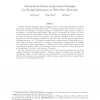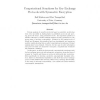469 search results - page 62 / 94 » On Adversary Models and Compositional Security |
ASIACRYPT
2005
Springer
14 years 1 months ago
2005
Springer
We introduce a new cryptographic primitive called the blind coupon mechanism (BCM). In effect, the BCM is an authenticated bit commitment scheme, which is AND-homomorphic. It has n...
CHI
2011
ACM
12 years 11 months ago
2011
ACM
Text-based passwords are the most common mechanism for authenticating humans to computer systems. To prevent users from picking passwords that are too easy for an adversary to gue...
ICALP
2007
Springer
14 years 1 months ago
2007
Springer
Motivated by the challenging task of designing “secure” vote storage mechanisms, we study information storage mechanisms that operate in extremely hostile environments. In suc...
PET
2005
Springer
14 years 1 months ago
2005
Springer
Parallel mixing [7] is a technique for optimizing the latency of a synchronous re-encryption mix network. We analyze the anonymity of this technique when an adversary can learn the...
CCS
2009
ACM
14 years 2 months ago
2009
ACM
Formal analysis of security protocols based on symbolic models has been very successful in finding flaws in published protocols and proving protocols secure, using automated too...


